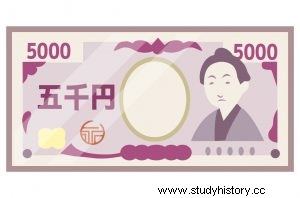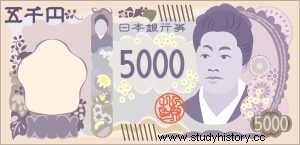This time as well, we would like to introduce the great people who have been selected as portraits of 5000 yen bills in response to the announcement that the banknotes will be renewed in 2024.
Everyone knows the first generation Prince Shotoku Mr. Miss.
In addition to the 5,000-yen bill, Taishi-san has 10,000-yen bills, 1,000-yen bills, and 100-yen bills. It is. At that time, "Banknote =Prince Shotoku" It seems that the image was big. In modern times, "Bill = Satoshi " Mr. Is it?
The second generation is Nitobe Inazo Mr. Miss.
After serving as many professors and principals, "I want to be a bridge between Japan and foreign countries" He has become the Deputy Secretary-General of the League of Nations.
This time, the second great man of the 5000 yen bill, the 3rd generation Higuchi Ichiyo
14 months as a novelist? What is Higuchi Ichiyo's life?

November 1, 2004 Issuance started. The portrait person is Ichiyo Higuchi Mr. Miss. The first woman on the Bank of Japan notes It's a portrait in.
At the time of Mr. Nitobe Inazo, the previous one, Ichiyo and other female candidates were raised to appeal the cleanliness, but he was not hired and became Mr. Inazo.
Murasaki Shikibu on the 2000-yen note issued in 2000 Is drawn, but it is not a portrait as expected. You're from the Heian period 1000 years ago.
Ichiyo Higuchi is a novelist from the Meiji era!
1872 (Meiji 5) , Tokyo Uchisaiwaicho Born under the father of a junior official in Nagaya. It is a place in front of Edo Castle in the middle of Tokyo. Her real name is "Natsu" And she sometimes called herself "Natsuko".
She has an older sister, two siblings, and a younger sister. She has been memorable since childhood, and at the age of four she entered elementary school and was a reading lover.
Okachimachi She transferred to school because she moved to, and then she graduated from Ueno school at the age of 12, but her mother "Women don't need to study!" Because of her idea, she did not advance to advanced school and quit her school.
However, her father made her learn waka poets for Mr. Ichiyo, and was introduced by her acquaintance to the poet Utako Nakajima . " Hagi no Ya I was introduced to Waka and learned Japanese poems and books.
Most of the students in Hagi no Ya were upper class girls, and there were more than 1000.
Under such circumstances, she was the daughter of a junior official, Mr. Ichiyo, but she was regarded by her teacher as having the highest score at the poetry.
Tanabe , the daughter of a famous family flower field " Two-year-old 媛 " It was called.
Mr. Hanabusa Tanabe was the first woman to publish a modern novel, and later, young women actively became a novelist, and Mr. Ichiyo was one of them.
Due to the death of my father and brother, I went to the novel path!
When Ichiyo was 10 years old, her second brother was disowned because of her bad behavior and financial problems.
The eldest son enrolled in Meiji Law School (later Meiji University) and then worked for the Ministry of Finance, but died of pulmonary tuberculosis.
His father also started a business after retiring from the Metropolitan Police Department, but failed and died leaving debt.
Mr. Ichiyo was supposed to carry the Higuchi family at the young age of only 17.
I lived and worked as an uchi-deshi in Hagi-no-ya, and worked in the office such as sewing and gettinga making, but that was not enough and I had a difficult life like borrowing money.
Meanwhile, Hanano Tanabe, a sister and apprentice of Hagi no Ya, published her novel and received a large manuscript fee of 33 yen. Ichiyo-san, who knew it, decided to write her from around the age of 18.
* The value of money in the Meiji era and modern times is 3800 times It is said that there was also "1 yen =3800 yen" about it. Moreover, it is not such a simple thing, and the value of money for the common people is "1 yen =20,000 yen" It is said that there was a lot.
Around 20 In addition to writing several articles, newspaper reporter and novelist Tosui Nakarai I started to study and receive guidance from Mr. Ichiyo, but Mr. Ichiyo's novel was not adopted.
Moreover, this relationship between the two Has spread in Hagi-no-ya, and has received fierce opposition from those around him. Breaking with Momomizu-san. You will be forced to do it.
After that, I was able to receive the manuscript fee of 11.50 yen by self-education and advice from Mr. Hanano.
There were times when I couldn't make progress, and for about a year at that time I opened a general store and had the experience of being the subject of a novel after her.
Why was it called the 14th month of miracles?
Around 22 From now on, Mr. Ichiyo's novel has come to show evaluation, Ogai Mori It will be highly evaluated among novelists.
She is only she dies of pulmonary tuberculosis at the age of 24 and 6 months However, her works released during the 14-month period just before her death were all memorable in the history of modern Japanese literature.
"14 months of miracles" It was even called.
The new banknote from 2024 is Umeko Tsuda!

She studied abroad in the United States at the age of six! ??
December 1864 , Born in Edo (currently Shinjuku-ku, Tokyo) to a father who was a bakushin.
The era is in the middle of the end of the Edo period. Only three years later, the Edo Shogunate disappeared and we entered the Meiji era. Very famous Ryoma Sakamoto Sanya Saigo Takamori , And Shinsengumi It was around the time when they were very active.
My father, who was a vassal of the shogunate, lost his job with the destruction of the shogunate, but he participated in the Hokkaido Development Commission, which was a project of the Meiji government. I am studying abroad in the United States.
Iwakura Tomomi Sanya Toshimichi Okubo "Iwakura Mission" dispatched by the leaders of the government to the United States and European countries for the purpose of amending the unequal treaty. I participated in. Of course, Umeko has nothing to do with the treaty revision.
Five female international students were selected, two of whom returned to Japan in about a year, but Umeko stayed in the United States for 11 years. Her father, who recommended her study abroad, may have thought, "So much !?"
On the contrary, don't you get used to Japan?
She was Umeko who returned to Japan, but because she was studying abroad at a young age, she became unfamiliar with Japanese and Japanese customs.
She learned Japanese herself, and while she was the first Prime Minister of Japan, Hirobumi Ito She is introduced to her and teaches English to imperial and Chinese girls.
She had been teaching English at a girls' school for about three years, but she didn't get used to the atmosphere of the upper class, and even refused several marriages, "Don't talk about marriage again." It was enough to say.
In Japan, where the tendency of men and women remains, unlike the United States, there was no place for women to work even if they had a higher education.
Around 25 , Her study abroad friend Alice Bacon She came to Japan, she decided to study abroad again at her recommendation, and she decided to go to the United States again.
We have added a one-year extension to the two-year study abroad program to help Bacon study at university, write a treatise, and study Japanese women who have returned to Japan. She is said to have inspired Umeko, who was unfamiliar with Japan, to become interested in her education for women.
Establishment of Tsuda College!
After returning from her three-year study abroad program, she will once again work as a teacher at Kazoku Girls'School, and will also serve as a professor at Meiji Girls' School and Girls' Higher Normal School.
Around 36 years old With the cooperation of her father, Bacon, and old friends who studied abroad together at an early age, "Women's English School (currently Tsuda College)" aims to educate girls without distinction between Chinese and commoners. I opened the school and became the head of the school.
At the Women's English School, we provided education to enable women to play an active role in society, rather than the etiquette that was traditionally used for women's education. It seems that there were many dropouts due to the harshness.
I also avoided financial assistance so that I would not be disturbed by such an original educational policy, but for that reason, I continued to have problems with lack of funds, such as working without compensation. Furthermore, management will become more difficult due to the increase in students and teachers.
Three years after the school opened, the number of people who wanted higher education increased in Japan, and applications for the establishment of vocational schools continued. "Professional School Ordinance" to establish a unified standard However, the women's English school became an incorporated association and management improved.
However, Umeko has been sick since this time, and when the basics of her cram school are in place, she she is around 54 . She resigned from her school, and she was forced to live a long-term illness in Kamakura.
And cerebral hemorrhage Because of 64 years She died in.
Later, the Women's English School was renamed Tsuda English School and opened as Tsuda College in 1948.
